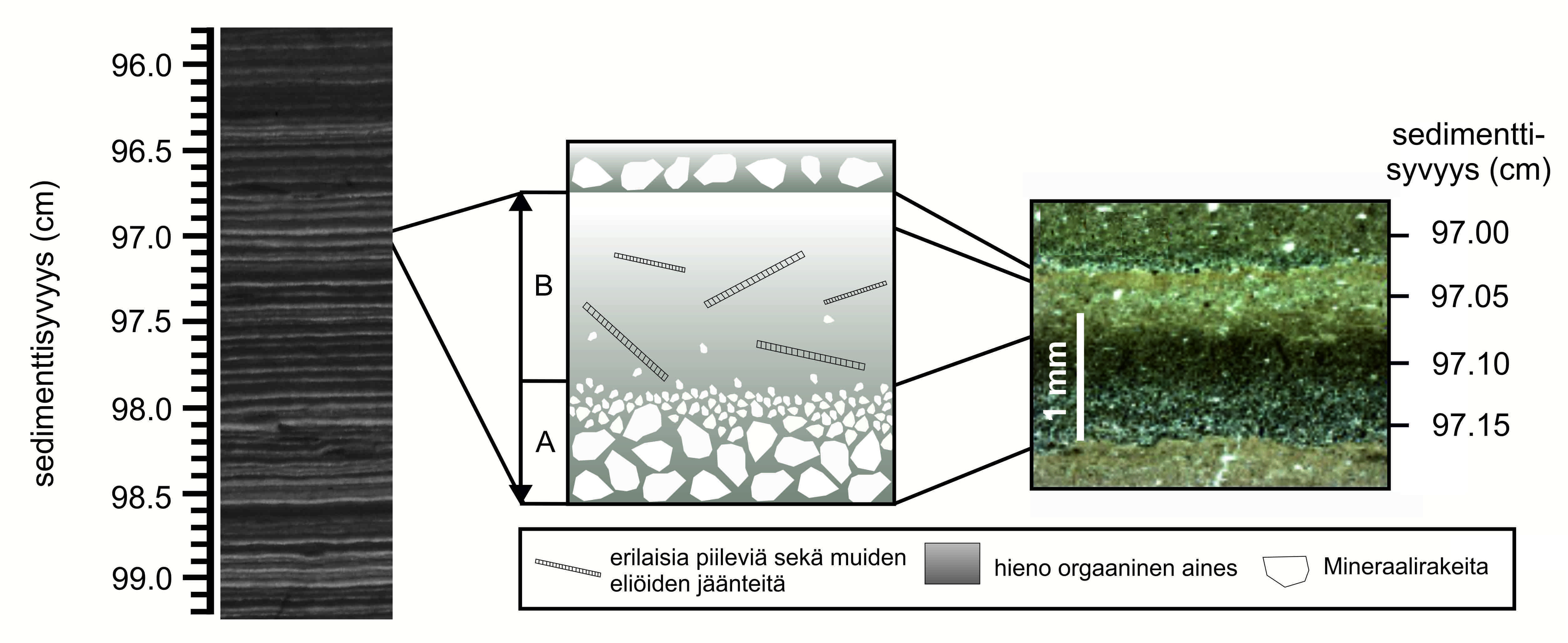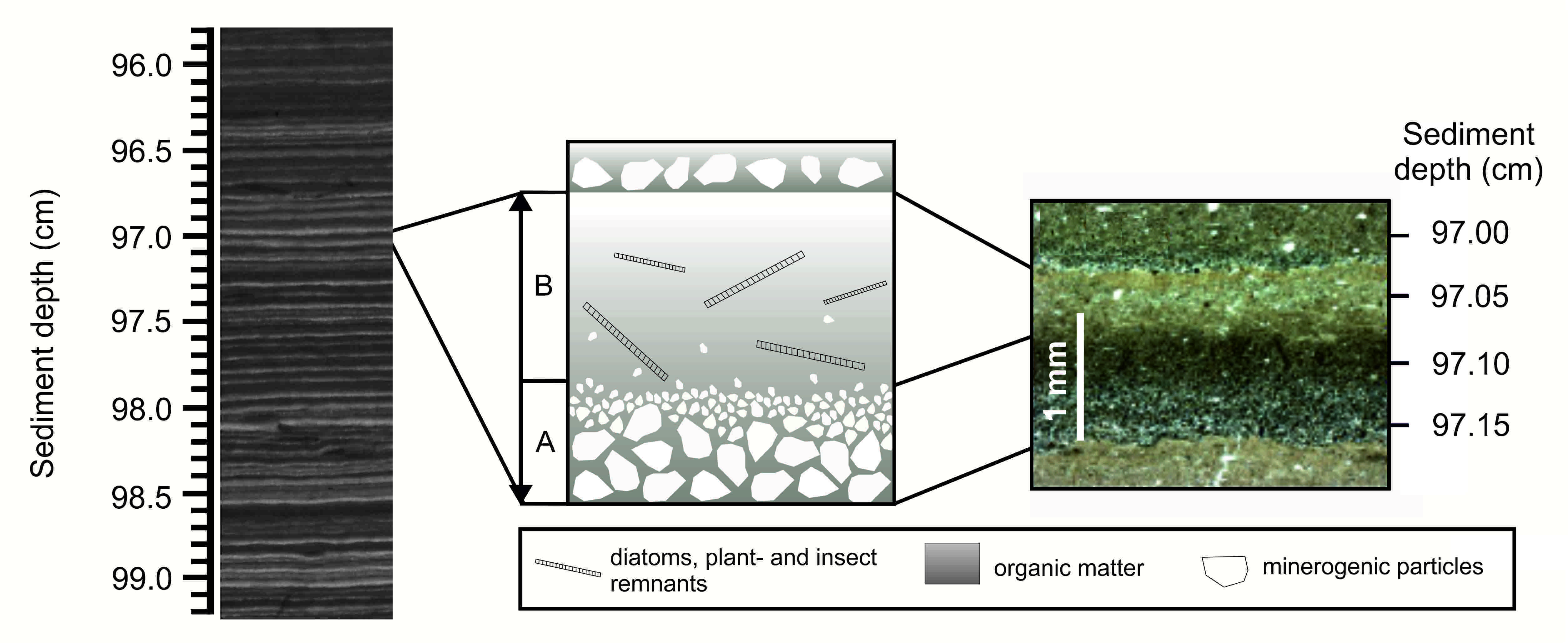 Saija Saarni on väitöskirjatutkija Turun yliopiston geologian osastolla. Hän tutkii vuosikerrallisista järvisedimenteistä muinaista ilmastoa ja ympäristöä. Myös vapaa-ajallaan hän viihtyy vedessä.
Saija Saarni on väitöskirjatutkija Turun yliopiston geologian osastolla. Hän tutkii vuosikerrallisista järvisedimenteistä muinaista ilmastoa ja ympäristöä. Myös vapaa-ajallaan hän viihtyy vedessä.
Saija Saarni is a PhD student in the Geology section in the University of Turku. She is studying past climate and environments from lake muds. In her free time she enjoys water sports.
Kevään merkit – millaisia merkkejä kevät jättää järvimutaan?
Kevät on erityisen tärkeää aikaa järvelle ja järvitutkijalle. Järven valuma-alueelta sulavat lumet, jääpeite katoaa, järvivesi alkaa lämmetä ja sekoittuu, ravinteet ja auringonvalo saavat järven elämän kukoistamaan. Kaikki nämä tapahtumat jättävät jälkensä myös järven pohjakerrostumiin. Järven pohjamutaa voi pitää eräänlaisena aikakoneena. Mitä syvemmälle mutaan kaivautuu sitä vanhempia kerrostumia voi saavuttaa.
Järven valuma-alueen tapahtumat vaikuttavat järvikerrostumiin monin tavoin, sen rakenteeseen, koostumukseen ja alkuainesuhteisiin, pohjalle hautautuvaan eliöstöön ja valuma-aleelta huuhtoutuvaan materiaaliin. Kerrostumisnopeus voi vaihdella hurjasti, mutta metrin matkalle vuosikerrallista järvisyvänteen mutaa mahtuu toista tuhatta vuotta. Tämä voi vaihdella hurjasti ja matalikoilla kerrostumisnopeus on suurempi kuin syvänteissä. Suomalaiset järvet ovat syntyneet viimeisimmän jääkauden jälkeen ja ne voivat parhaimmillaan säilöä pohjilleen jopa 10 000:n vuotta vanhaa mutaa.
Vähähappisissa oloissa syvällä järven pohalla kerrostumat voivat säilyä järjestyksessä. Sedimenttiä kutsutaan vuosikerralliseksi eli lustosedimentiksi. Lustot järven pohjalla muistuttavat paljon puiden vuosirenkaita. Myös ne syntyvät vuodenaikojen vaihtelun aiheuttamista muutoksista. Keväisin kevättulvat huuhtovat maa-ainesta järven valuma-alueelta josta muodostuu ohut, mutta selvästi havaittava vaalea mineraalipitoinen raita. Mineraaleja kerrostuu sitä enemmän mitä runsaampi tulva on. Tulvan suuruuteen taas vaikuttaa lumimäärä ja sen sulamisnopeus sekä tietysti jääpatojen syntyminen. Kesän aikana kerrostuu orgaanista, eloperäistä ainesta, joista syntyy tumma kerros. Vaalea ja tumma raitapari edustaa yhtä vuotta. Lustot voivat jatkua vuosituhansia taaksepäin ja niiden avulla on mahdollista tutkia muinoin vallinnutta ilmastoa ja sen vaihteluita.

Vasemmalla röntgenkuva järvilustoista. Vaaleat raidat (A) koostuvat mineraalirakeista, lähinnä kvartsista ja maasälvästä, joka syntyy kevättulvien seurauksena. Tummat raidat (B) koostuvat orgaanisesta aineksesta, jossa on mm. piileviä, siitepölyjä sekä kasvien ja hyönteisten jäänteitä. Oikealla mikroskooppikuva, jossa näkyy kuinka suuremmat ja raskaammat mineraalirakeet ovat painuneet pohjalle ensin ja tummempana, ennen ruskeana näkyvää orgaanista kerrosta, ovat pienemmät rakeet, jotka laskeutuvat pohjalle hitaammin.
Mitä kevättulvakerros sitten kertoo tutkijoille? Se kertoo kuinka talven lumimäärä on vaihdellut läpi vuosi tuhansien. Esimerkiksi pimeä keskiaika näyttäytyy ilmastotutkimuksen valossa hyvinkin leutona. Keskiajan lämpökauden Itä- ja Keskisuomen nietokset olivat selvästi keskimääräistä pienempiä. Lustot kertovat myös, että auringon aktiivisuuden muutokset vaikuttavat siten, että talvet ovat keskimäärin runsaslumisempia kun auringon aktiivisuus on minimissään. Tätä ei voida tulkita suoraan niin, että ilmasto jäähtyy kun auringon aktiivisuus laskee, sillä satellittimittausten mukaan esimerkiksi 11-vuotinen auringonpilkkusykli aiheuttaa enimilläänkin vain 0.2 °C lämpötilavaihtelun. Mekanismit ovat paljon monimutkaisemmat ja liittyvät ilmakehässä tapahtuviin hienoisiin muutoksiin. Kevättulvakerroksen on havaittu myös heijastelevan Pohjois-Atlantin oskillaatiota, NAO-ilmiötä joka vaikuttaa ilman paine-eroihin Atlantilla. Kasvaneet paine-erot Islannin matala-paineen ja Azorien korkeapaineen välillä vahvistavat länsituulia. Atlantilta puhaltavat voimistuneet tuulet tuovat kosteutta aina Suomeen asti, joka talvella ilmenee lumisateina. Yksittäinen pieni järvi voi tallentaa yläpuolella temmeltävien ilmamassojen liikkeet, se voi kertoa oliko talvi luminen, leuto vai ehkä molempia? Geologille järvimuta on kuin kirja, joka kertoo järven tarinan sen synnystä nykyisyyteen ja jopa tulevaan.
Jos kiinnostuit, lue lisää Auringon vaikutuksesta tai Pohjois Atlantin Oskillaatiosta.
Signs of spring – how are they imprinted in lake muds?
The spring is an important time of year for lakes and people studying lakes. The snow is melting, the ice cover is getting smaller and smaller, the lake water is warming up and its nutrients are being mixed, while sunlight enables life to flourish. All these events leave an imprint in the lake muds. Lake sediments are like a time machine, the deeper you go the further back in time you travel.
The events happening at the lake catchment affect lake sedimentation in many ways, the sediment structure, composition and element ratio. The sedimentation rate in Finnish lakes varies a lot, but in the annually laminated or so-called varved sediment records, one meter of sediments covers more than a thousand years. Finnish lakes were formed after the ice sheet retreat of the last glaciation. This means that, potentially, the sediments in the Finnish lake floors may be about 10 000 years old.
In the anoxic depths, the sediment may preserve the order of accumulation. Varved lake sediments, resemble tree rings. The lake varves are formed due to the difference between the seasons. In spring, the melting of snow causes flooding that washes away minerogenic particles from the catchment to the lake. The particles form a thin minerogenic lamina on the lake floor that can be seen with the naked eye. The more intensive the flooding episode, the more particles are eroded from the catchment. Flood intensity, on the other hand, depends on the amount of snow, the speed of snow melting and, for example, on the damming of ice blocks. During summer, organic matter forms a dark lamina. The fair and dark couplet forms a varve that represents one year of sedimentation. The varves may keep on forming year after year, for thousands of years, and by studying these structures it is possible to study past climate and its variations.
At left an x-ray image from varved lake sediments. The bright layers (A) consist on minerogenic particels, mainly quartz and feldspar. The layer or so-called lamina forms as a result of spring floods. Dark laminae (B) consist on organic matter including pollen, diatoms, plant and insect remnants.At right a microscopic image where can be seen hoe the bigger and heavier particles are deposited first and the smaller lighter ones, seen as darker laminae just before brownish organic matter sink slower through the water column.
What are the spring laminae telling then? They can tell how the amount of snow has been varying over the last thousands of years. For example dark middle ages in Central Finland seems to have been dark in a sense, that there was much less snow during winters on that time than on the average. It has been observed that more snow is accumulated during the periods of low solar activity. This does not directly mean that it is cold when the sun has less active phase. Satellite measurements have shown a variation of only 0.1 °C in relation to the 11-year sun spot cycle. This is accompanied by a 0.1-0.2 °C fluctuation in global average surface temperatures. The mechanisms of solar forcing are related to small changes and chain reactions occurring in the atmosphere. The phase of North Atlantic Oscillation (NAO) matters as well. During the positive NAO phase, the westerly air flows from the Atlantic are stronger carrying humid air further to the east. This is reflected even in Finland, with an increase in snowing. A single small lake and its catchment can record the movements of air masses above them; they can also tell whether the winter was snowy or warm or both. The lake mud is like a history book for geologists, muds can write down the history of the lake from its early initiation to the present and even future.
If you got interested read more about solar forcing and North Atlantic Oscillation.
